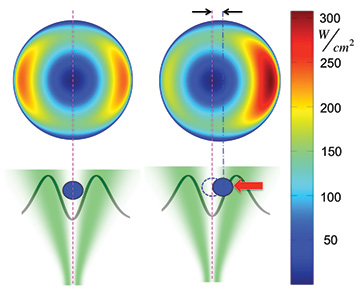
When a microbead is centered in an optical funnel, the photophoretic force is balanced (left). But if the bead shifts, the heating increases on one side, causing a restoring force back toward the center (right). [Credit: N. Eckerskorn et al., Phys. Rev. Appl. (2015)]
Just as a cook uses a common funnel to pour liquids through a small opening, researchers have devised a touch-free “optical funnel” that holds micron-scale particles in a precise location (Phys. Rev. Appl., doi: 10.1103/PhysRevApplied.4.064001 ). Scientists could someday use the optical-vortex method to confine biomolecules at the focal point of an X-ray free-electron laser.
The optical funnel, as devised by an international team led by Andrei V. Rode of Australian National University (Canberra), arises from a thermal force that is transferred from the gas molecules surrounding the target particles to the particles, provided that the latter are heated unevenly. Scientists call this effect “photophoresis,” and it differs from the radiation pressure due to momentum transfer by photons, the force exploited in the optical traps devised by OSA Honorary Member Arthur Ashkin nearly a half-century ago.
Rode and his colleagues created a diverging hollow-core vortex beam from a 532-nm-wavelength CW laser beam using a 16-step radial phase plate. Into the vortex, the team released a spherical particle made of either solid graphite or a graphite-coated glass shell; in various experiments, the diameters of the graphite particles ranged from 2 to 12 μm and the shells from 10 to 100 μm. The team conducted its tests in air at various pressures from 5 mbar to 2 bar. The researchers had to map out and calibrate all the different piconewton-scale forces impinging on these particles, including the dependence of the photophoretic force on the air pressure in the experimental chamber.
Several challenges remain before scientists can implement the scheme in a practical end-user system, such as determining the maximum laser intensity that an individual particle's surface can handle before changing its physical or chemical properties (or destroying the particle completely). Rode and his colleagues aim to use the optical funnel to conduct structural morphology experiments on proteins and other biological molecules with an X-ray laser such as the one at the DESY Center for Free-Electron Laser Science in Germany, where several group members work.
Members of Rode’s team are also affiliated with the universities of Glasgow and Cambridge (U.K.), Arizona State University (USA) and the University of Hamburg (Germany).
